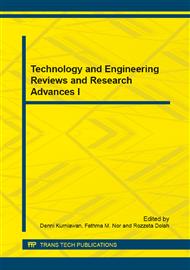p.117
p.122
p.128
p.141
p.145
p.149
p.154
p.159
p.163
The Impact of Metakaolin on Early Days Strength of Nanotechnology Modified Sandwich ECC
Abstract:
Metakaolin is a produce from Kaolinite. Meanwhile, Kaolinite is a natural clay mineral that consists of so many mineral materials, metakaolin inclusive, that can be used in many areas of life and hence sustainable in contents if process adequately. The issue of global warming coupled with a general belief of greenhouse gas emission through the production and usage of cement, a main building and infrastructures construction materials, necessitate for the substitution of cement in building materials most especially concrete. This study focused on the effect of metakaolin on the early day's strength of sandwich engineered cementitious concrete modified with nanosilica particles. The nanosilica in this mix served two purposes, one as a cementitious substitute and secondly as to increase the silica content of the normal sand used. The fresh and engineering properties of samples with 12% weight replacement of ordinary Portland cement with metakaolin was also evaluated. The surface area of metakaolin used in this experiment was 25.4m2/g. The result shows that the sandwich ECC samples modified with nanosilica produced higher strength compared with the base standard M45 ECC.
Info:
Periodical:
Pages:
145-148
Citation:
Online since:
February 2015
Authors:
Price:
Сopyright:
© 2015 Trans Tech Publications Ltd. All Rights Reserved
Share:
Citation:


